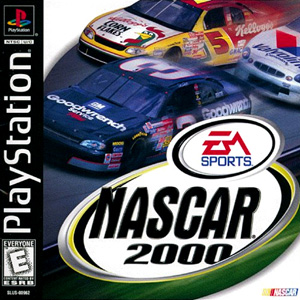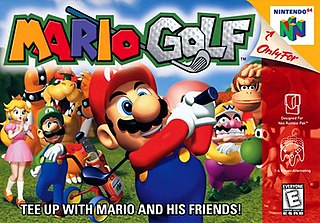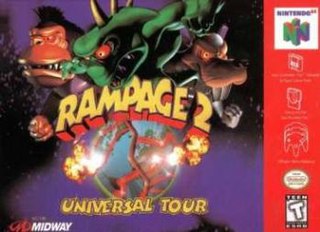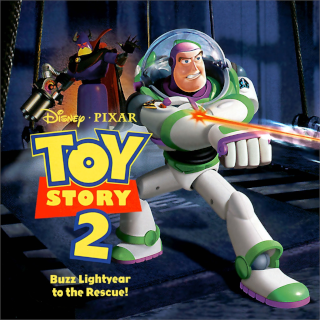
Mario Tennis is a 2000 sports video game developed by Camelot Software Planning and published by Nintendo for the Nintendo 64. Following Mario's Tennis, it is the second game in the Mario Tennis series. The game is known for being the introduction of Luigi's arch-rival, Waluigi, and the re-introduction of Princess Daisy and Birdo.

Donald Duck: Goin' Quackers is a platform video game developed and published by Ubi Soft for various consoles and Windows-based personal computers. A different game with the same title was first released for the Game Boy Color, as well as on Game Boy Advance, the latter being given the title Donald Duck Advance.

Ready 2 Rumble Boxing is a boxing video game developed by Midway Studios San Diego, and published by Midway in 1999 for the Dreamcast, PlayStation, Game Boy Color, and Nintendo 64. The success of the Dreamcast version led to it becoming one of the few Sega All Stars titles.

NASCAR 2000 is a racing simulator video game developed by Stormfront Studios and published by EA Sports.

Vigilante 8 is a vehicular combat video game developed by Luxoflux and published by Activision for PlayStation, Nintendo 64, and Game Boy Color. Although officially it has no connection to the Interstate '76 series, it features several of its themes.

NBA Showtime is a basketball arcade game released by Midway in 1999, featuring teams and players from the National Basketball Association (NBA). The game is modeled after the NBA presentations on NBC and takes its name from NBC's NBA pregame show. It is the successor to Midway's previous basketball titles NBA Hangtime and NBA Jam and is the first in the series to have fully 3-D polygonal graphics, featuring real uniforms for all teams. Showtime was also featured in a dual game cabinet along with NFL Blitz 2000 that Midway dubbed the "SportStation." Midway followed up the game with the console exclusive NBA Hoopz.

Madden NFL 2000 is a football video game. This was the second of the Madden NFL games to not solely feature John Madden on the cover in North America. The only other one was Madden NFL '95. Most versions of the game cover featured Madden prominently in the foreground, and a recognizable Barry Sanders in a background action graphic. The European PAL edition features only Dorsey Levens on the cover.

WCW Mayhem is a professional wrestling video game published by Electronic Arts (EA), based on the American promotion World Championship Wrestling (WCW). The first WCW game produced by EA, it was released for Nintendo 64 and PlayStation in 1999 and for the Game Boy Color the following year.

WWF Attitude is a professional wrestling video game based on the World Wrestling Federation released by Acclaim Entertainment in 1999 for the PlayStation and Nintendo 64. A slightly enhanced port of the game was later released for the Dreamcast, as well as a handheld version for the Game Boy Color. The game is named after the WWF's then-current "Attitude" marketing campaign, with the tagline "Get it" also being used on company programming during that period.

Mario Golf is a 1999 sports game developed by Camelot Software Planning and published by Nintendo for the Nintendo 64. Mario, his friends, and his enemies play golf on a variety of Mario-themed courses. Following NES Open Tournament Golf, it is the second game in the Mario Golf series. Camelot also developed a Game Boy Color version, which adds role-playing elements.

Mickey's Speedway USA is a Disney racing game for the Nintendo 64 and Game Boy Color, developed by Rareware and published by Nintendo under license from Disney Interactive. It is styled after other kart racers such as Mario Kart 64 and Diddy Kong Racing, and features characters from the Mickey Mouse universe racing across the United States. It is Rare and Nintendo's second Disney-themed racing game following Mickey's Racing Adventure (1999).

Rampage 2: Universal Tour is a 1999 action game developed by Avalanche Software and published by Midway. It is the third game in the Rampage series and a sequel to 1997's Rampage World Tour.

South Park is a first-person shooter video game based on the American animated sitcom of the same name. The game was developed by Iguana Entertainment, using a modified version of the engine used in the Acclaim Entertainment-published Turok 2: Seeds of Evil; both games shared the same publisher and were released for the Nintendo 64 in 1998 in North America, and for Microsoft Windows in 1999. South Park was released in Europe and ported to the PlayStation in the latter year to coincide with the film South Park: Bigger, Longer & Uncut.

Armorines: Project S.W.A.R.M., known as Armorines in Europe, is a 1999 first-person shooter developed by Acclaim Studios London and released for the Nintendo 64, Game Boy Color and PlayStation. It is based on the Armorines comic book from Valiant Comics, which was bought by Acclaim Entertainment.

Magical Tetris Challenge is a puzzle game by Capcom for the Nintendo 64, Game Boy Color, and PlayStation. It is a version of Tetris featuring Disney characters. It is one of the few Nintendo 64 games to be entirely in 2D, in addition to being Capcom's first game for the console.

Polaris SnoCross is a snocross snowmobile racing game for Game Boy Color, PlayStation, Nintendo 64, and later Microsoft Windows. It was released in 2000. French publisher Wanadoo Edition released a budget version of the game for the PC in 2001, called SnowCross.

Toy Story 2: Buzz Lightyear to the Rescue! is a 1999 platform game developed by Traveller's Tales and published by Activision and Disney Interactive. Based on Disney/Pixar's 1999 computer animated film Toy Story 2, it was released for the Nintendo 64, PlayStation, Microsoft Windows, and Macintosh in late 1999, while a Dreamcast version followed in 2000. The computer versions were released under the title Disney/Pixar's Action Game, Toy Story 2. A different version, a side-scrolling platform game titled Toy Story 2, was also released for the Game Boy Color in 1999.

Gex 3: Deep Cover Gecko is a 1999 platformer video game and the third and final installment of the Gex video game series, which released in 1999 and 2000 for the PlayStation, Nintendo 64, and Game Boy Color. Its protagonist, Gex, is a wisecracking, pop culture enthusiast voiced by Danny John-Jules in the UK and European releases and comedian Dana Gould, reprising his role from former Gex games, for the American release. The gameplay is set in Gex's secret hideout, Mission Control a overworld, which is overseen by Gex's butler, Alfred the Turtle. Playboy model Marliece Andrada plays Gex's kidnapped companion, Agent Xtra, the only live-action character, who is featured in brief full-motion video sequences on the PlayStation version. The plot follows Gex's return to the Media Dimension to rescue Agent Xtra from Rez, Gex's arch-nemesis from the previous games.

Army Men: Air Attack is a third-person shooter video game developed and published by The 3DO Company for PlayStation, Nintendo 64, Game Boy Color and Microsoft Windows. The game focuses on aerial combat and features the same protagonist, Cpt. William Blade. It is one of the first Army Men games to be powered by a 3D engine where terrain and units are rendered in real-time.

Tarzan is a 1999 platform game based on the 1999 film of the same name. Versions were released in North America for the Game Boy Color on June 28, 1999, PlayStation and Microsoft Windows on June 30, 1999, and Nintendo 64 in February 15, 2000. In 2012, the PlayStation version was made available on the PlayStation Store for PlayStation Vita.




















